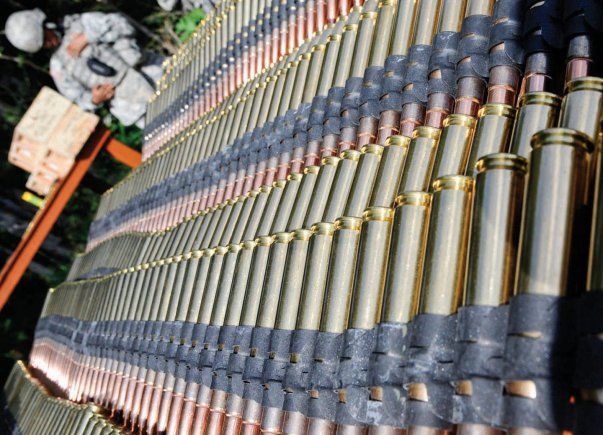An enemy convoy transporting a supply of fuel rumbles across the desert floor, an ideal target for armor-piercing incendiary projectiles.
These projectiles are most useful for “after-armor effects,” such as an incandescent flash immediately after penetrating a hard target. The resulting plume may be useful for devastating any fuel-storage facilities by igniting the fuel vapors.
The Army uses a formulation called IM-28 that is charged into certain armor-piercing incendiary projectiles, which can be fired from such weapons as the M2, M3, and M85 machine guns.
The problem with the in-service IM-28 is that it contains two harmful chemicals. At Picatinny Arsenal, the Pyrotechnics Division of the Armament Research, Development and Engineering Center is working to develop an alternate formula that is friendlier to the environment. The center is part of the U.S. Army Research, Development and Engineering Command.
Picatinny researchers are working to remove the harmful chemicals barium nitrate and potassium perchlorate from the IM-28 baseline mixture and replace them with a chemical known as sodium metaperiodate.
The result is an environmentally safer mixture that remains within the Environmental Protection Agency’s regulatory levels for perchlorates (15 parts per billion) as well as those of the state of New Jersey (5 parts per billion).
However, reformulating military devices, such as pyrotechnics, is challenging as chemists aim to develop formulations that not only reduce risk on the environment, but are also safe to handle, manufacture, and shows comparable performance to IM-28.
“Addressing all those things at once, it’s like trying to hit a silver bullet,” said Jesse Sabatini, a formulation chemist at the Pyrotechnic Division.
The push for ecology-friendly devices gained greater impetus after studies indicated that some barium compounds and perchlorates have debilitating effects on the environment, manufacturers and the Soldier.
Perchlorates are ubiquitous in commercial fireworks and airbags. But, research also shows that perchlorates are a teratogen, thyroid disruptor, and can interfere with proper thyroid function.
Similarly, chemicals such as barium nitrate are hazards to occupational health and have been linked to bronchoconstrictor effects. In a military environment, the risks can multiply.
After pyrotechnic munitions combust, for instance, the chemical residue can leech into the ground water and air at training sites. When the Soldier is exposed, it negatively affects the Soldiers’ health, as well as hampers the ability to train and prepare for combat, which can reduce combat readiness.
“It’s not only important to face the problems of today, but it’s also important to face the problem five or ten years down the road,” said Sabatini.
The idea to create perchlorate-free munitions has been of interest since the late ’90s, when researchers developed perchlorate-free simulators, such as the flash bang which is a non-lethal device that produces a loud report useful for training or riot control.
But, it wasn’t until Jared Moretti, a formulation chemist, arrived at Picatinny that the ideas of replacing barium nitrate and perchlorate with sodium metaperiodate gained traction.
“It [sodium metaperiodate] was a chemical I routinely used as a graduate student for a different application. So, we tried it “explained Moretti, who earned his doctoral degree in organic chemistry from the University of Pittsburgh, in 2010.
Working with the Naval Service Warfare Center at Crane and Alliant TechSystems, known as ATK, the Pyrotechnic Division tested a range of formulations that varied in composition.
Each composition had defined increments of chemicals and contained no perchlorates or barium.
Observing how sensitive each mixture was to impact, friction, and electrostatic discharge (the flow of electricity between two objects), results showed that two main oxidizers worked best in the compositions: strontium nitrate and sodium metaperiodate.
These two formulations were then sent to ATK, where manufacturers blended the mixture and charged it into bullets, testing it for incendiary flash and penetration. Testing showed was that one formulation with sodium metaperiodate approached the function test scores of IM-28 and was also brighter.
Testing took more than a year and the new oxidizer has now found widespread application in many ongoing research programs in energetic materials. Incendiary rounds and illuminant signals, are just some examples of product improvement programs that have exploited the new oxidizer.
“When the chemical is implemented into the full device, its test scores are comparable to the in-service IM-28,” explained Moretti. “We have very good reason to believe that we can tweak the manufacturing parameter like charge weight — the amount of powder in each bullet — to further improve performance.”
Still, being ecology-friendly isn’t the only advantage to the reformulation.
Due to the fact that the mixture only requires two chemicals, manufacturers are able to drastically streamline the formulation process from the IM-28, cutting down on production time.
On the other hand, cost varies depending on the availability of the material. While sodium metaperiodate is currently more expensive than perchlorates or barium, Sabatini believes supply and demand will change this.
“You have to look at the total life cycle of an item that is being produced,” said Sabatini. “Even though perchlorates are cheaper to manufacture today, regulatory pressures associated with the production, remediation, and disposal of the material will drastically increase life-cycle costs.”
Instead, the reoccurring issue that Sabatini and Moretti often find themselves against is simpler: obtaining supplies.
Early in testing, for example, the Pyrotechnics Division developed a formulation that required the use of coated aluminum powder, a chemical whose coating makes it reactive. However, given the short supply, the ability to obtain coated aluminum is often a struggle.
Sabatini and Moretti avoided this issue by eliminating the need for coated aluminum powder altogether.
Future steps for the reformulation of the IM-28 include tests to qualify the formula and performance tests for the applications, a process scheduled to occur throughout 2014.










